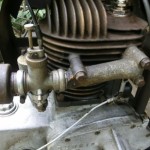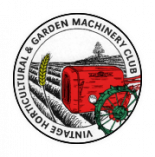Forum Replies Created
-
AuthorPosts
-
August 6, 2014 at 7:01 pm #9575
 wristpinParticipant
wristpinParticipantThe M in the Mk5M tells you that it’s probably a metric bearing . I say probably because it’s not unknown for machines to be “cut and shut” over the years and someone may have fitter an imperial bearing and holder at some poit. In fact your spare shaft assembly may have come from an imperial machine.
When you get the bearing out you may find the size imprinted in the outer race. If it’s imperial it’s probably an RL5 or RLS5. If it’s metric possibly a 1203 or 6203.
To get your good sprocket off without damaging it you will either need grips or a stilsons that are thin enough to grip on the boss behind the toothed part or devise a way of gripping the toothed part without damaging it. Having worked on dozens of Marqueses over the years I made a long bar with a bit of quarter plate welded to the end with four pins that engaged the teeth of the sprocket – spreading the load over four teeth.
A commercially available chain wrench or even a short length of chain wrapped around the sprocket and then gripped with stilsons are other options.
The bearing itself is a light interference fit on the shaft and can be removed with one of your legged pullers.August 5, 2014 at 6:58 pm #9558 wristpinParticipant
wristpinParticipantIt’s screwed on with a conventional right hand thread so that it tightens under drive. A bit of heat will help but they can be very tight. However as the sprocket is already damaged the job is made easier – you can grip or with the biggest stilsons that you can muster without fear of expensive damage . A second set of stilsons on the shaft and plenty of grunt!
If you don’t already know, the driven sprocket on the cutting cylinder is left hand thread -again, so that it tightens under drive.August 1, 2014 at 9:55 pm #9527 wristpinParticipant
wristpinParticipantProblem viewing these!
July 9, 2014 at 8:41 pm #9138 wristpinParticipant
wristpinParticipantShield/baffle , one and the same!
July 9, 2014 at 4:33 pm #9108 wristpinParticipant
wristpinParticipantWould have thought that if the oil is coming from the exhaust you would be enveloped in white smoke! Are you sure that it’s not coming from the crankcase breather in the valve chest?
The breather is a small poppet valve installed in the floor of the valve chest and held in place with a spring hooked over the stud that holds the chest cover in place. If you remove the cover you should find a tin shield. Fiddle that out and you should see the breather valve which consists of a small circular casting (the body) with two lugs to locate it. Also a fibre washer between it and the valve chest floor.Within the body is a paxolin disc and over the top a steel cap all held in place by the spring.
The disc is free to rise when the downward stroke of the piston displaces crankcase air and should seal against the casting on the upward stroke and by so doing maintain some negative pressure in the crankcase to retain oil.
Both the disc and it’s seat in the body wear and the valve looses effectiveness.Sometimes turning the disc over to present an unworn face to the body helps.
Of course, there is the possibility that someone has been in there and either assembled it incorrectly or left a bit out!July 3, 2014 at 9:47 pm #8966 wristpinParticipant
wristpinParticipantI would agree with that interpretation of the chassis tag numbers but no idea whether the engine numbers indicate a date of manufacture. As for parts, auction sites and auto jumbles.
June 25, 2014 at 10:18 pm #8788 wristpinParticipant
wristpinParticipantThink that the French Gravely addict is on the forum as andre-MAZET
June 24, 2014 at 11:47 am #8764 wristpinParticipant
wristpinParticipantAfter posting my reply re your gangs something was bothering me and then the penny eventually dropped (age thing!) – they appear to hitched up the wrong way round!. It’s more usual to have the single unit leading. That sent me burrowing through the manuals but all I could find is an operators manual for the very early units where their Antelope ancestry is very apparent. Looks as though your hitch may have originally been for a five set rather than a three. Anyway it may be of interest
https://www.dropbox.com/s/s4io0a0f5au44c2/Ransomes%20Junior%20Gangs0001.pdf
On the wobbly wheel issue I am wondering whether as they have a cast wheel running on a steel (hardened?) pin that the wear is more likely to be in the wheels. If the pins mic’ up more or less standard would an option be to put oilite bushes into the wheels. If you go the new pin route you would probably have to true up the bores in the wheels anyway.
Just a thought!
In the early 80s when the councils were changing from cylinder mowers to rotaries we could buy as many Antelopes as we wanted and in quiet times used to make up hitches etc and sell them as gang sets. Fortunately there was a guy in Worthing who had a thing about Sloper engines and would take them all to re-engine 17″ Suffolks etc. As you might guess we didn’t bid against each other!June 22, 2014 at 9:37 pm #8740 wristpinParticipant
wristpinParticipantSpecifically these are J5 gangs, based Antelope units, some of the early versions even still had the sprockets on the left end of the cylinders. Make sure that there is no wheel wobble which, if not attended to, will lead to the drive pinions destroying themselves and the ring gears cast into the insides of the wheels. Both the pinions and the wheels are getting hard to find so it may be worth inspecting them all sooner rather than later.
June 18, 2014 at 8:13 pm #8705 wristpinParticipant
wristpinParticipantThe L shaped lever is connected to the centrifugal governor within the crankcase and when the engine running should be opposing the pull of the throttle cable via the governor spring. With the engine running you should be able to feel the lever trying to close the throttle. If you can’t feel any reaction from the lever it’s possible that there is an internal problem but I would check and double check the external set up before ripping things apart.
June 10, 2014 at 6:15 pm #8603 wristpinParticipant
wristpinParticipantIf it’s any help the part number was L08043. Latterly F016L08043
June 9, 2014 at 9:43 pm #8597 wristpinParticipant
wristpinParticipantWill the nut from an old cast iron block Suffolk fit ? They were were basically a Briggs made under licence. No shortage of them!
June 8, 2014 at 3:19 pm #8572 wristpinParticipant
wristpinParticipantIt will cause some imbalance and a little reduction in cooling but that said I’ve seen a lot worse running with no signs of distress. If the engine runs ok with no undue vibration I would just Keep Calm and Cary On!
May 31, 2014 at 8:19 pm #8480 wristpinParticipant
wristpinParticipantYes, a RAL or Pantone code will be ideal otherwise it will be a case of getting an existing bit scanned. The problem with BS engines of that era (1983) is that there is not much in the way of “hidden areas” that have not been subject to fading as they didn’t paint the inside of the blower housing or air filter canister.
May 31, 2014 at 3:12 pm #8474 wristpinParticipant
wristpinParticipantShould have said that the colour of your engine is what Briggs were using for all their replacement engines in the mid 1970s well into the 80s.
I have no idea about dating an MT by its serial number or even it one can. Presume that you already know that the first two digits of the BS Code give you the year – for what its worth in this case! -
AuthorPosts
